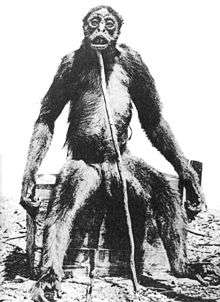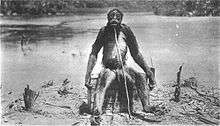De Loys' Ape
 de Loys' Ape 1920. | |
| Grouping | Cryptids |
|---|---|
| Sub grouping | Hominid, primate |
| Other name(s) |
Ameranthropoides loysi, Ateles loysi |
| Country | Colombia–Venezuela border |
| Region | Tarra River |
| Habitat | Rainforest |
De Loys' Ape, given the proposed scientific names Ameranthropoides loysi and Ateles loysi, is an alleged large primate reported by Swiss geological explorer François de Loys in South America. The only evidence for the animal besides de Loys' testimony is one photograph. It was promoted by George Montandon as a previously unknown species, but is now usually considered a misidentification of a spider monkey species or a hoax.[1]
Encounter
François de Loys, a Swiss oil geologist, led an expedition from 1917 to 1920 to search for petroleum in an area along the border between Colombia and Venezuela, primarily near Lake Maracaibo. The expedition was unsuccessful, and furthermore suffered greatly due to disease and skirmishes with natives; of the 20 members of de Loys' group, only four survived.
According to de Loys' later report, in 1920, while camped near the Tarra River, two large creatures approached the group. Initially, de Loys thought they were bears, but then noted that they were monkey-like, holding onto shrubs and branches. The creatures – one male, one female – seemed angry, said de Loys, howling and gesturing, then defecating into their hands and flinging feces at the expedition. Fearing for their safety, the expedition shot and killed the female; the male then fled. De Loys and his companions recognised that they had encountered something unusual. The animal resembled a spider monkey, but was much larger: 1.57 m tall (compared to the largest spider monkeys, which are just over a metre tall). De Loys counted 32 teeth (most New World monkeys have 36 teeth), and noted that the creature had no tail.
They posed the creature by seating it on a crate and propping a stick under its chin. After taking a single photograph, de Loys reported, they skinned the creature, intending to keep its hide and skull. Both items were later abandoned by the troubled expedition.
According to other reports, more photographs were taken but were lost either in a flood or during the capsizing of the scientists' boat.
Publication
After de Loys returned to Europe, he kept the story of the unidentified ape to himself until 1929. That year, his friend the anthropologist George Montandon was perusing de Loys's files, seeking information about South America's native tribes. Montandon discovered the photograph, and thought it to be very important. De Loys finally related his account in the Illustrated London News of June 15, 1929, and three scientific articles regarding the creature were published in French journals. Montandon suggested a scientific name for the creature: Ameranthropoides loysi.[1]
Controversy
After this publicity, de Loys’ account was deemed unreliable by several critics, notably Sir Arthur Keith, a prominent anthropologist. Keith suggested de Loys was trying to pass off a normal spider monkey as something more exotic. The photograph did not clearly indicate the creature's size, and Keith also noted that by not photographing the creature’s posterior, de Loys had left open the question of whether or not it had a tail. Keith suggested the animal in the photo was a spider monkey, perhaps a black spider monkey (Ateles paniscus), which had been manipulated to appear different. Countering Montandon, Keith suggested the scientific name Ateles loysi.[1]
Most later writers have agreed that the creature in the photograph is a spider monkey. Others, such as the cryptozoological researcher Ivan T. Sanderson, disagreed with Keith about the species, suggesting the white-bellied spider monkey (Ateles belzebuth) to be more similar in appearance and shape.[1] Sanderson further noted that the particular area in which de Loys allegedly encountered the ape had no history of reports of oversized primates. He regarded the identification as an unknown ape "an outright hoax, and an obnoxious one at that, being a deliberate deception."[2]
Other researchers, such as cryptozoologists Loren Coleman and Michel Raynal, also support the theory that the creature is a hoax based on a photograph of a spider monkey, and argue that Montandon was the perpetrator. Montandon used the Ameranthropoides loysi to support his view that the human races had independently evolved from different primates found in their regions. He had previously argued that the white race had evolved from early Homo sapiens, while Africans evolved from gorillas and Asians from orangutans; he proposed the Ameranthropoides loysi was a "missing link" ancestor to the Indigenous peoples of the Americas.[1][3]

Since then, research has come to light, noted on Coleman's blog, suggesting that the stump of a banana tree can be seen at the right side of the entire photograph. Bananas are not indigenous to South America, making their occurrence in the remote jungle highly implausible, thus making it probable that the photo was not shot at the location deLoys indicated.[4] This argument and other findings which strongly indicate a hoax, largely the result of Spanish-language work by Venezuelan scientists Bernardo Urbani and Angel Viloria, were essentially unknown to cryptozoology researchers prior to the summer of 2007. In 2009, Urbani and Viloria translated and published their findings in English.[5]
Of those who believe de Loys encountered an unknown species, some suggest it was a surviving Protopithecus brasiliensis, a large spider monkey of the Pleistocene era, or connect it to the legend of the "Mono Grande" reported in the area later in the 20th century.[1]
References
- 1 2 3 4 5 6 Eberhart, George M. (2002). Mysterious Creatures: A Guide to Cryptozoology. ABC-CLIO. ISBN 1576072835. Retrieved December 8, 2013.
- ↑ De Loys' Ape - Unknown Hominid or Just a Hoax?
- ↑ Newton, Michael (2005). "De Loys's Ape". Encyclopedia of Cryptozoology: A Global Guide. McFarland & Company, Inc. pp. 128–129. ISBN 0-7864-2036-7.
- ↑ De Loys’ Well-Known Prank
- ↑ Viloria, Bernardo Urbani [and] Ángel L. (2008). Ameranthropoides loysi Montandon 1929 : the history of a primatological fraud = La historia de un fraude primatológico. Buenos Aires, Argentina: LibrosEnRed. ISBN 1597544450.
Further reading
- Jerome Clark, Unexplained! 347 Strange Sightings, Incredible Occurrences, and Puzzling Physical Phenomena (Visible Ink Press, 1993).
- Eberhart, George M. (2002). Mysterious Creatures: A Guide to Cryptozoology. ABC-CLIO. ISBN 1576072835. Retrieved December 8, 2013.
- Bernard Heuvelmans, On The Track Of Unknown Animals (Hill and Wang, 1958).
- Michael Shoemaker, "The Mystery of Mono Grande", Strange Magazine, April 1991.
- Karl P.N. Shuker, Extraordinary Animals Revisited (CFZ Press, 2007).
- Bernardo Urbani and Angel L. Viloria, Ameranthropoides loysi Montandon 1929: the History of a Primatological Fraud / Ameranthropoides Loysi Montandon 1929: la historia de un fraude primatologico (Libros en Red, 2009).
External links
- De Loys' Ape and What to Do With it @ Scientificamerican.com
- "Skeptoid #302: De Loys' Ape". Skeptoid.
- http://imgur.com/Elwd6VH
_2.jpg)